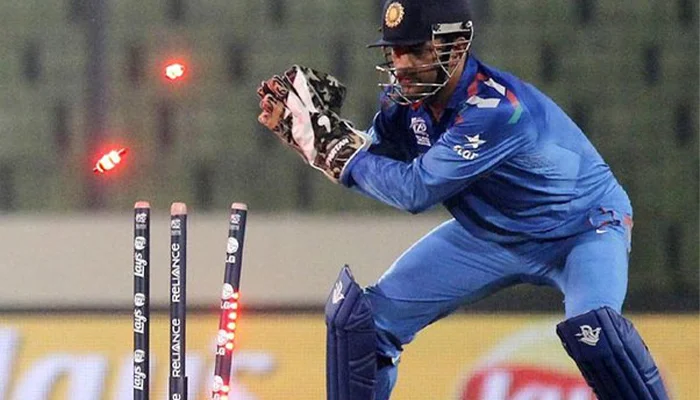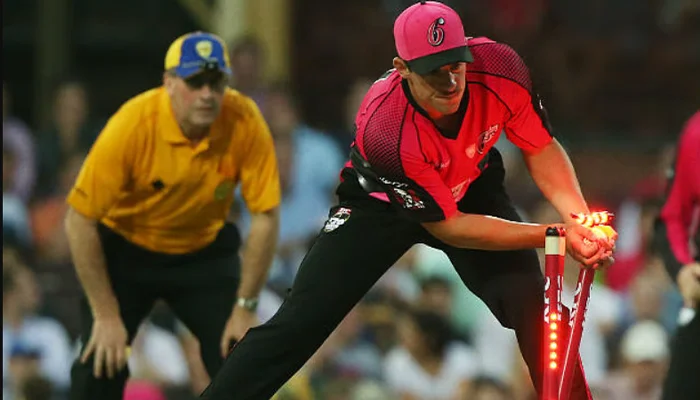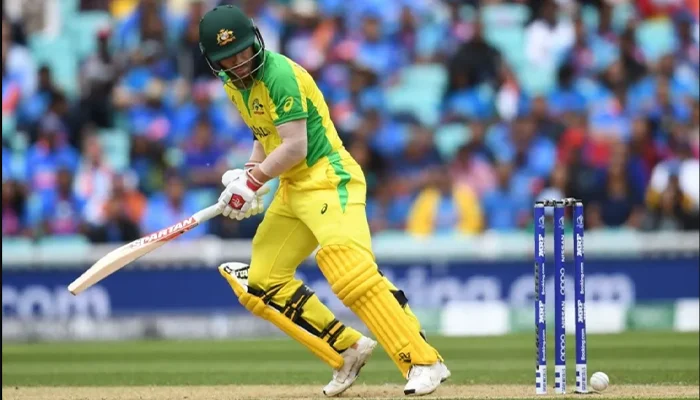Zing Bails: An innovation for the Gen Z fans

(Zing bails and stumps light up as MS Dhoni completes a stumping)
Cricket, which made its debut in the mid-1800s, has undergone significant transformations since then. Fans have observed not only changes in bat sizes but also experimented with different ball colours, showcasing the dynamic nature of the sport. As cricket keeps changing, it's interesting to think about what new ideas and perspectives the younger generation could bring. Imagine how they might rethink the importance of the stumps in the game. And this is where the idea of Zing Bails evolved where the stumps and bails will have LED lights and it will light up once a ball touches it. But, What's the purpose of this change, and how will it make things easier for the match officials? That's the question at hand.
How did the idea of Zing Bails come into existence?
The term "Zing" was coined because of the Australian company, Zing International, which is responsible for creating these fantastic bails and stumps. However, the real excitement lies not just in the name but in the fascinating story that accompanies it. The director of Zing International, David Ligertwood has given a story about his business partner Bronte Eckermann who was lying in his bed while his daughter was playing with an LED toy that used to light up while touching it. And this is where he combined the concept of this with the stumps and bails that would light up once someone touches it.
The lights in the bails assist match officials in making decisions during the game, especially when deciding if a batsman is out. These lights only flash when both ends of the bail completely break away from the stumps, ensuring a clear signal for the dismissal. The introduction of these bails addresses a long-standing issue in cricket. Stumping and run-out decisions were challenging because it was hard to pinpoint exactly when bail was taken off the stump. Zing Bails offered a simple and convenient solution by lighting up immediately upon removal, allowing every camera angle to contribute to making accurate decisions.

(Bronte Eckermann, the man who invented the concept of Zing Bails)
However, the task of creating this set wasn’t as easy and it took new dynamics to create a new pair of stumps along with bails. Because cricket uses a hard ball, they had a tough time in the early stages figuring out how to take wickets and bails that could handle the strong force. They had to design the circuit boards carefully so they wouldn't break when hit. Making a product that could endure the impact of a hard ball was already a big task, and on top of that, it had to handle the pressure from a hard ball going at 160kmph.
Working of Zing Bails
Once the idea of Zing Bails was passed by the cricket governing bodies, the main task was to implement it on the field. With all the studies going on, the proper working of Zing Bails was then finalized by the former Australian grade cricketer Bronte Eckermann. Zing bails work using special batteries and a tiny computer called a microprocessor. The microprocessor is smart in that it can figure out when the bails touch the stumps. When both ends of the bail break away from the stumps, something amazing happens: the bails light up super fast, in just 1/1000th of a second! This quick lighting up tells everyone that a player is out.
But the microprocessor doesn't stop there. After the bails light up, it sends a signal to the stumps using radio waves. It's like the bails telling the stumps, "Hey, I'm out!" and then the stumps light up too. This whole process happens really quickly and makes it clear to everyone when a player is dismissed. So, in simple terms, Zing Bails has special batteries and a clever microprocessor that quickly lights them up when a player is out. They also send a message to the stumps, making the whole wicket-dismissal moment even more exciting for players and fans.
To make sure the new Zing Bails and stumps were working well, they went through many tests. Even the International Cricket Council (ICC) ran their own tests to check how reliable they are. These tests were like experiments to see if the bails and stumps would work correctly during real matches. They looked at things like how fast the ball was going, how hard it hit, and different weather conditions.
The Debut of Zing Bails in Cricket
After understanding how Zing Bails work and making sure they're dependable, it was time to use them in real cricket matches. The first appearance was in Australia's Big Bash League (BBL) 2012, becoming the first tournament to have Zing Bails. Before this, they were first tried out in a regular local club match in Australia. It's like they practised in a small game first, and when everyone saw that it worked well, they brought it to the big leagues like the Big Bash League. So, the fans got to see Zing Bails for the first time on TV during these exciting matches in the BBL.

(Zing Bails made its debut in the 2012 Big Bash League)
In the International circuit, the Zing Bails came into existence in the 2014 T20 World Cup that was held in Bangladesh. However, the set of Zing Bails along with the stumps comes with a heavy price. The stumps used in the 2022 T20 World Cup tournament were of around INR 24 lakhs, while the bails were priced at INR 50,000. This means one set of wickets adds up to INR 25 lakhs. Since there are two sets on the field, the total cost doubles, reaching a substantial INR 50 lakhs. Investing a lot of money in cricket equipment shows that the game is moving towards using more advanced tools. It underlines how much importance is given to bringing in the latest technology for a better and more exciting game experience.
Are Zing Bails a Blessing or a Curse for Cricket?
The Introduction of Zing Bails has been working as a miracle for the cricket fans along with the team that is responsible for the decisions taken on the field. Cricket had a tough time deciding when bails were taken off the stumps for stumping and run-out calls. It became even harder with more cameras and the Decision Review System. Zings came to the rescue by lighting up as soon as the bails were removed. This simple solution made it easy for every camera angle to help referees make the right call. Zings not only fixed the long-standing problem of figuring out dismissals but also brought quick and effective to make decisions, keeping up with the changes in cricket technology.
But the story doesn’t end here. With the advantages that come out with the zing bails, there have been some cases where it has proved to be a curse for the players. Before these fancy ones came into play, winning teams used to collect the stumps after a cricket match. MS Dhoni, especially, loved doing this after his team won. But during the 2015 World Cup in Melbourne, after beating Pakistan, when Dhoni was going to get the stump, the umpire Ian Gould stopped him.

(David Warner looking as the Ball Hits the Stump, But the Bails Stay On!)
Furthermore, there have been instances where the zing bails have refused to fall down even after the ball touches them and hence the decision is made in the favour of the batters. Just like in the 2019 ODI World Cup where David Warner defended a short-length delivery and it went back to the stumps. However, the zing bails refused to come out, and hence Warner wasn’t given out here. This isn't a one-time thing as it has happened in various matches. Batters get lucky when the bails stay put, even after the ball hits them. This has led to situations where decisions favour the batsmen because, technically, they should be out, but the bails have other plans.

Comments
Sign up or log in to your account to leave comments and reactions
0 Comments